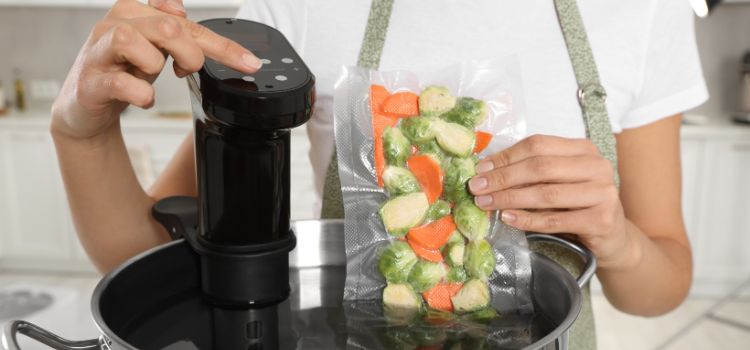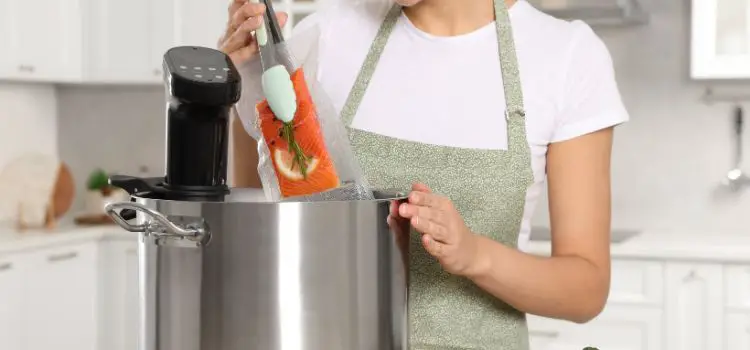As an Amazon Associate, I earn from qualifying purchases

Sous vide cooking has emerged as a culinary trend that not only appeals to professional chefs but also to home cooks seeking precision and ease in their cooking methods. This technique, which involves vacuum-sealing food and cooking it in a water bath at a controlled, consistent temperature, offers unparalleled convenience and consistency.
Many people appreciate its ability to produce perfectly cooked meals with minimal effort and fuss. As the popularity of sous vide continues to rise, so does the curiosity about using it efficiently. One common question is whether it’s possible to sous vide food in its original packaging. This idea is tempting because it seems to offer a shortcut, bypassing the need for additional preparation steps. However, determining whether this approach is viable and safe requires careful consideration of various factors.
Types of Original Packaging Used for Food
When exploring the possibility of sous vide in original packaging, it’s crucial to understand the types of packaging commonly used in the food industry. These packages are designed for storage and transportation rather than cooking, so their suitability for sous vide varies.
- Plastic Wraps: Often used for fruits, vegetables, and deli meats, plastic wraps are thin and flexible. While they offer protection from external contaminants, they are typically not heat-resistant.
- Vacuum-Sealed Bags: Many meats, fish, and processed foods come in vacuum-sealed bags. These are more robust than plastic wraps and might seem ideal for sous vide cooking. However, not all vacuum-sealed bags are made from materials that can withstand the heat levels used in sous vide.
- Shrink Wraps: Commonly used for bulk meats and cheeses, shrink wraps tightly conform to the shape of the product. Like vacuum-sealed bags, their heat resistance can vary.
Safety Considerations of Using Original Packaging in Sous Vide
Using original packaging in sous vide cooking raises several safety concerns, primarily related to the materials used in these packages.
- Chemical Leaching: Many plastics contain chemicals like phthalates and BPA, which can leach into food when exposed to heat. This process can pose health risks, making it essential to ensure that any packaging used is free from harmful chemicals.
- Regulatory Guidelines: It’s important to refer to regulatory standards for food-safe packaging. Agencies like the FDA have guidelines that determine which materials are safe for food contact at various temperatures.
- Durability Under Heat: Original packaging might not be designed to withstand prolonged exposure to heat. This can lead to melting or breaking down, compromising the integrity of the bag and the safety of the food inside.
Tips for Determining if Packaging is Suitable for Sous Vide

If you’re considering using original packaging for sous vide, there are ways to assess its suitability.
- Check for Heat Resistance Labels: Look for packaging labels that indicate whether the material is heat-resistant. Some packaging may carry symbols or text that specify temperature limits.
- Conduct a Water Test: Before cooking, place the packaging in hot water to test its durability. If the package holds up without any signs of melting or deformation, it may be safe for sous vide.
Alternative Packaging Options
To ensure both safety and optimal cooking results, consider these alternative packaging options:
- Sous Vide-Specific Bags: These bags are explicitly designed for sous vide cooking, made from BPA-free, food-safe materials that can withstand high temperatures without leaching chemicals.
- Silicone Pouches: Reusable and environmentally friendly, silicone pouches are another excellent option for sous vide. They provide a robust seal and are heat-resistant.
- Resealable Vacuum Bags: These bags allow you to create a customized vacuum seal, perfect for sous vide. They are often made from safer materials, ensuring both safety and the ability to lock in flavors effectively.
Conclusion
While the idea of sous vide cooking in original packaging might seem appealing for its convenience, it carries risks that should not be overlooked. The potential for chemical leaching and packaging failure under heat makes it crucial to assess each situation carefully. Opting for sous vide-specific bags or other safe alternatives ensures that you can enjoy the benefits of this cooking technique without compromising safety.
As you explore sous vide cooking, experimenting with recommended packaging solutions can enhance your culinary experience. Engaging with online communities and resources can further enrich your understanding and help you navigate the nuances of sous vide cooking with confidence.
FAQ
Can you sous vide in the original package?
It depends on the packaging material. Many original packages aren’t designed to withstand sous vide temperatures and may release harmful chemicals. Always check for heat-resistant labels. For safety, it’s generally better to transfer food to sous vide-approved bags specifically designed for cooking.
Can you sous vide meat in the bag it comes in?
Using the bag meat comes in is risky unless it’s specifically labeled as heat-safe. Most commercial packaging isn’t intended for cooking and may not handle sous vide temperatures safely. It’s advisable to repackage meat in sous vide-compatible bags to ensure safety and optimal cooking results.
What type of packaging is used for sous vide?
Sous vide cooking typically uses vacuum-sealed bags made from food-safe, heat-resistant materials. These bags are designed to withstand high temperatures without leaching chemicals. Alternatively, reusable silicone pouches are popular for their environmental benefits and ability to seal flavors effectively during cooking.
As an Amazon Associate, I earn from qualifying purchases